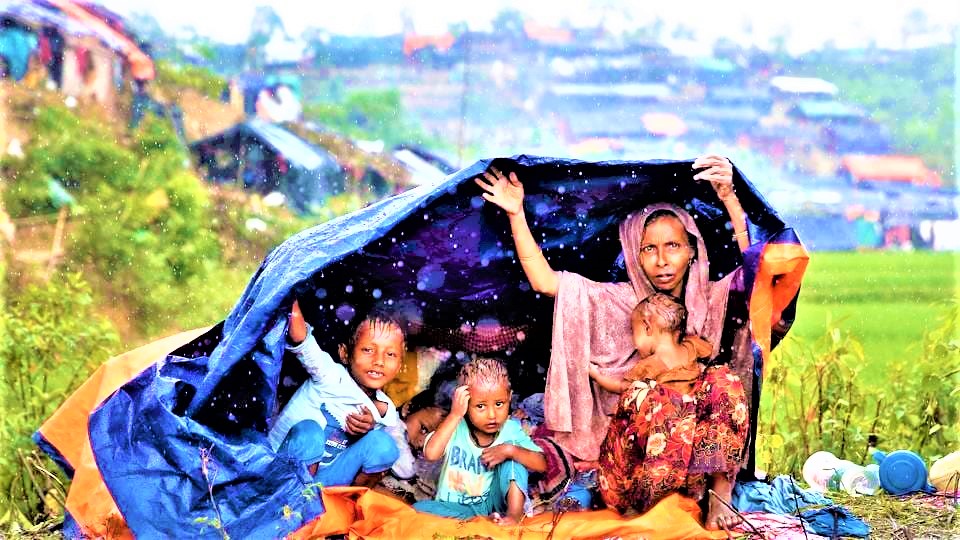The Children of the Gods of War (Part 2): The Ongoing Rohingya Genocide
TRANSCEND MEMBERS, 5 Sep 2022
Prof Hoosen Vawda – TRANSCEND Media Service
“The Impact on Children of the Mass Exodus of Rohingya Muslims from Myanmar by Peace Disruptors” [1]
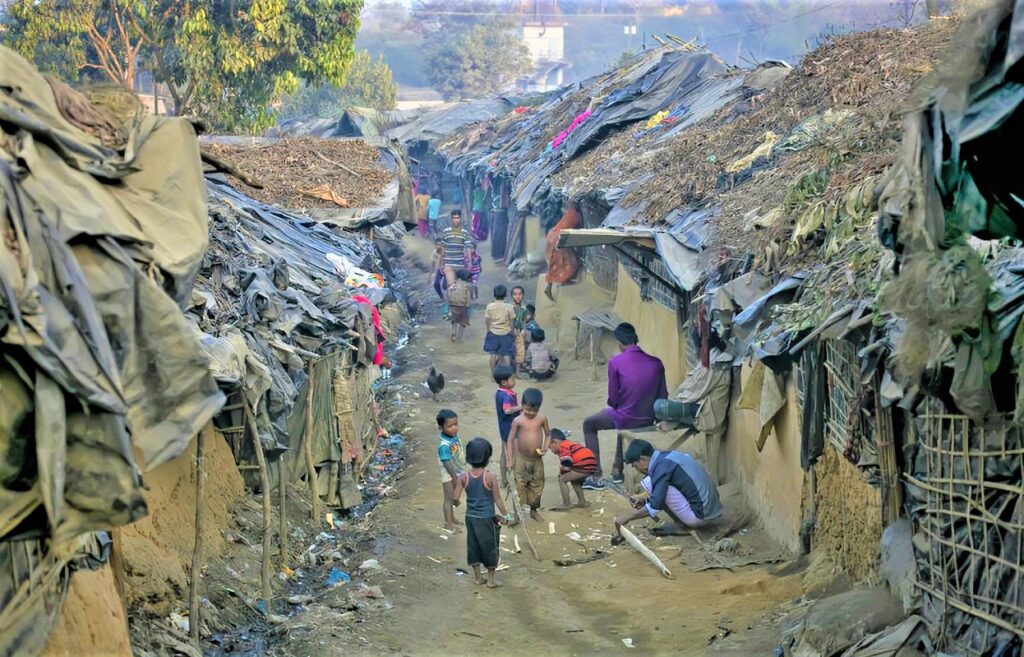
The squalid conditions in which Rohingya children are “nurtured” in Cox’s Bazaar Refugee Camp, in Bangladesh. Image Credit AFP
3 Sep 2022 – This series of publications, document the global plight of the children and minors who are the subjects of the fallout from regional conflicts and wars and who are maximally impacted, growing up as a “lost generation” or more seriously as future peace disruptors knowing nothing, but violence as a solution to their challenges in life or critically, as future terrorist to inflict their revenge on the society which caused their primary problems. This is a new outcome and threat on the aspect of the psychosocial development, the western powers have failed to acknowledge, since the children are being constantly subjected to, in their formative years of their lives, while incarcerated in refugee camps, or growing under foreign occupiers, experiencing daily war and conflict scenarios as in occupied Gaza by Israeli Defence Force.
It is worthwhile presenting the background of the Rohingyas and the reasons for the genocide of 2017, leading to the mass exodus from Myanmar. The Rohingya genocide is a series of ongoing persecutions and killings of the Muslim Rohingya people by the Burmese military[2]. The genocide[3] has consisted of two phases[4] to date: the first was a military crackdown that occurred from October 2016 to January 2017, and the second has been occurring since August 2017.[5] The crisis forced over a million Rohingya to flee to other countries. Most fled to Bangladesh, resulting in the creation of the world’s largest refugee camp,[6] while others escaped to India, Thailand, Malaysia, and other parts of South and Southeast Asia, where they continue to face persecution. The United States, United Kingdom, and other countries refer to the events as “ethnic cleansing”.
The persecution of Rohingya Muslims in Myanmar dates back to at least the 1970s.[7] Since then, the Rohingya people have been persecuted on a regular basis by the government and Buddhist nationalists.[8] In late 2016, Myanmar’s armed forces and police launched a major crackdown against the people in Rakhine State which is located in the country’s northwestern region. The Burmese military was accused of committing ethnic cleansing and genocide by various United Nations agencies, International Criminal Court officials, human rights groups, journalists, and governments.[9] found evidence of wide-scale human rights violations, including extrajudicial killings; summary executions; gang rapes; arson of Rohingya villages, businesses, and schools; and infanticides. The Burmese government dismissed these findings by stating they are “exaggerations”.[10] Using statistical extrapolations which were based on surveys which were conducted with a total of[11] Rohingya refugee households in Cox’s Bazar, Bangladesh, a study which was conducted in January 2018 estimated that the military and the local Rakhine population killed at least 25,000 Rohingya people and perpetrated gang rapes and other forms of sexual violence against 18,000 Rohingya women and girls. They estimated that 116,000 Rohingya were beaten, and 36,000 were thrown into fires.[12]
The military operations displaced a large number of people, triggering a refugee crisis. The largest wave of Rohingya refugees fled Myanmar in 2017, resulting in the largest human exodus in Asia since the Vietnam War.[13] According to UN reports, over 700,000 people fled or were driven out of Rakhine State, and took shelter in neighbouring Bangladesh as refugees as of September 2018. In December 2017, two Reuters journalists who were covering the Inn Din massacre were arrested and imprisoned. Foreign Secretary Myint Thu told reporters Myanmar was prepared to accept 2,000 Rohingya refugees from camps in Bangladesh in November 2018.[14] Subsequently, in November 2017, the governments of Bangladesh and Myanmar signed a deal to facilitate the return of Rohingya refugees to Rakhine State within two months, which drew mixed responses from international onlookers.[15] The UN High Commissioner for Human Rights, Michelle Bachelet, visited Bangladesh and the Rohingya camps near the border with Myanmar in early August 2022. Reports covered that Bangladesh’s Prime Minister, Sheikh Hasina asked the refugees to return to Myanmar. However, the UN addressed that repatriation needs to be conducted in a voluntary and dignified manner, and when the conditions on the border and also in Myanmar are safe for the process.[16] In late August 2022, the UN special envoy held another discussion with Bangladesh leaders, acknowledging the major pressures as a host country. At the same time, the UN emphasized the importance of engaging the Rohingya in direct discussions and decisions making processes about their future and for minimizing marginalization.[17]
The 2016 military crackdown on the Rohingya people was condemned by the United Nations, which cited possible “crimes against humanity”, the human rights organisation Amnesty International, the United States Department of State, the government of neighbouring Bangladesh, and the government of Malaysia. The Burmese leader and State Counsellor, de facto head of government and Nobel Peace Prize laureate Aung San Suu Kyi was criticised for her inaction and silence over the issue and did little to prevent military abuses.[18] Myanmar also drew criticism for the prosecutions of journalists under her leadership.[19]
The August 2017 persecution was launched in response to Arakan Rohingya Salvation Army attacks on Myanmar border posts. It has been labeled ethnic cleansing and genocide by various United Nations agencies, ICC officials, human rights groups, and governments.[20] The UN described the persecution as “a textbook example of ethnic cleansing”. In late September 2017, a seven-member panel of the Permanent Peoples’ Tribunal found the Burmese military and authority guilty of the crime of genocide against the Rohingya and the Kachin minority groups.[21] Suu Kyi was again criticised for her silence over the issue and for supporting the military actions.[22] In August 2018, the office of the United Nations High Commissioner for Human Rights declared that Burmese military generals should be tried for genocide.[23] On 23 January 2020, the International Court of Justice ordered Myanmar to prevent genocidal violence against its Rohingya minority and to preserve evidence of past attacks.[24]
This publication highlights the ongoing peace disruption in Myanmar, as new reports emerge of killings of Rohingyas, who are returning to their homelands and who are still regarded as “Bengalis by the military Junta of Myanmar. In 2017 the persecution of the Rohingyas in the Rakhine state of Myanmar led to the mass displacement of the Burmese Muslims, the Rohingyas to the neighbouring Bangladesh, having settled in Cox’s Bazaar, where the children have grown up. in the greatest slum on mother Earth.
The Rohingyas are thought to have migrated from what is now Bangladesh to Rakhine state, which was then known as Arakan, during the 17th century. When Myanmar gained independence from British colonial rule in 1948, the Rohingya were left stranded in Rakhine state; no longer Bangladeshi, but viewed by the newly-independent nation of Burma, presently known as Myanmar, as outsiders, called Bengalis by the Buddhist country. They were denied citizenship under Myanmar’s 1982 Citizenship Law, effectively rendering them stateless.
Imagine if the readers of this publication living a permanent life, in a sprawling, makeshift “city” of tents and shacks, under absolutely squalid conditions, with a perimeter fence to keep the residents penned in, with no access to education or any way to earn a living, dependent entirely on humanitarian aid to survive. The reality is that this is the life for the one million Rohingya, Muslim refugees who have been settled, virtually incarcerated, for five long years in the “purgatory” of the world’s largest refugee camp, in Cox’s Bazar on the eastern shoreline of Bangladesh.
Their present sad plight began in late August 2017, when more than 700,000 Rohingyas fled a brutal military crackdown and campaign of ethnic cleansing in Myanmar’s Rakhine state. This was the beginning of the Rohingya Genocide, which was initially denied by the international community, including certain NGO’s in South Africa, because the killings were based on religious grounds of been Muslims. This great exodus of stateless people, joined about 300,000 who were already living in the sprawling network of camps in neighboring Bangladesh.
The chairman of the United Nations Independent International Fact-Finding Mission on Myanmar stated that Facebook played a “determining role” in the Rohingya genocide.[25] Facebook has been accused of enabling the spread of Islamophobic content which targets the Rohingya people.[26] The United Nations Human Rights Council has called the platform “a useful instrument for those seeking to spread hate”.[27]
In response, Facebook removed accounts which were owned by the Myanmar Armed Forces because they had previously used Facebook to incite hatred against the Rohingya people,[28] and “engaging in coordinated inauthentic behavior.”[29] In February 2021, Facebook banned the Myanmar military from its platform and set up rules to ban Tatmadaw-linked businesses.[30]
On 6 December 2021, approximately a hundred Rohingya refugees launched a $150 billion lawsuit against Facebook, alleging that it did not do enough to prevent the proliferation of anti-Rohingya hate speech because it was interested in prioritizing engagement.[31]
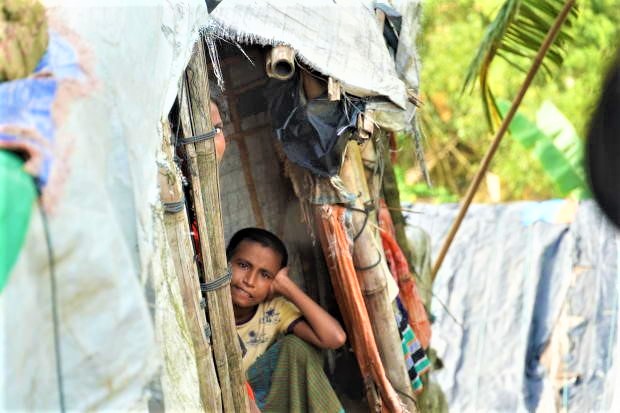
25 Aug 2022 at the five-year anniversary of the exodus to Bangladesh. What the future holds? A Rohingya child is seen at a refugee camp in Cox’s Bazaar, Bangladesh.
Photo Credit: MD. Kamruzzaman/Anadolu Agency/Getty
On 12 September 2018, the OHCHR Independent Fact-Finding Mission on Myanmar published its report to the United Nations Human Rights Council.[32] Following 875 interviews with victims and eyewitnesses since 2011, it concluded that “the Burmese military has consistently failed to respect international human rights law[33] and the international humanitarian law principles of distinction, proportionality and precaution.”
All NGOs and humanitarian agencies, including UN agencies, are bound by the humanitarian principles of humanity, impartiality, neutrality, and independence.[34] As the 2018 Independent Fact-Finding Mission Report highlighted, UN agencies were aware of Rohingya persecution for almost three decades, with five consecutive Special Rapporteurs on the situation of human rights in Myanmar having been appointed since 1992.[185] However, the Independent Fact-Finding Mission Report noted: “While Myanmar was repeatedly identified as a crisis situation requiring a human rights-driven response by the “whole of the United Nations”, this approach was rarely, if ever, taken. Rather, many United Nations agencies have continued to prioritise development goals, humanitarian access, and quiet diplomacy. That approach has demonstrably failed, and the United Nations as a whole has failed adequately to address human rights concerns in Myanmar. Even now, the approach taken displays few signs of any lessons learned, with human rights missing from agreements recently signed with the Government.”
There has been widespread criticism of United Nation agencies over the years in the handling of the Myanmar Genocide, The United Nation’s continued attempts to cooperate with the Myanmar Government, despite the Government’s unwillingness to acknowledge or address the Tatmadaw’s persecution of the Rohingya,[35] has allowed the humanitarian crisis to worsen. Although this approach complies with the common interpretation of other humanitarian principles, such as neutrality and impartiality, it neglects the core humanitarian principle of humanity. For example, a suppressed internal United Nation report[36] heavily criticised the UN Country Team for ineffectively focusing on development and investment rather than on addressing the root causes of the persecution. Moreover, a September 2017 BBC investigation reported that, in an attempt to promote investment into Myanmar, UN officials prevented human rights activists travelling to Rohingya areas, tried to shut down public advocacy on the subject, and isolated staff that warned of ethnic cleansing.[37] Despite these criticisms of the UN’s approach, in June 2018 the UNDP and UNHCR entered an MoU with Myanmar Government providing for the reparation of Rohingya to Myanmar.[38] On 13 November 2018, the plan to repatriate an initial 2,200 Rohingya was abandoned due to protests by Rohingya refugees.[39]
Presently, in 2022 and five years later, these disowned, stateless mass of humanity , with a large number of children and minors are still struggling to obtain even the most basic necessities, like food, and there are no prospects, nor reasons to hope for better days in the near future. “Nothing has changed in these five years,” Khin Maung, a 27-year-old refugee at the camp, told CBS News. “We are still suffering and struggling for basic needs every day. We don’t have a safe environment in the camps, and we are really worried for the future of our children who are not able to go to school… this is our biggest concern.”[40] Over 50% of the Rohingya refugees at Cox’s Bazar are children. Bangladesh’s government has not allowed them access to any formal education. It also has not given the adult refugees any employment rights, leaving the entire population of the camp reliant entirely on humanitarian aid, and that has dwindled over the past five years.
“Five years on, the situation in the camps, in fact, is worse, because the funding has dried up as the focus has shifted to the war and the resultant humanitarian crisis in Ukraine,” Fiona McLysaght, Bangladesh country director[41] for the international humanitarian organization Concern Worldwide, told CBS News. “It’s still an emergency situation, where we are trying to meet their basic needs.”
The makeshift structures of the cramped camp are prone to fires that can spread with devastating speed. Blazes have killed dozens of refugees over the past five years, including a massive one that tore through the camp in March 2021, claiming 15 Rohingya lives, leaving hundreds more injured and thousands displaced all over again.[42] The low-lying coastal camp is also highly vulnerable to flooding during South Asia’s rainy season. Climate change and the extreme weather patterns it is driving have also hit Cox’s Bazar hard, with the annual monsoon rains bringing flooding and landslides that inundate the tent city and compound the difficulties of relief work. The United Nations refugee agency and other humanitarian aid organisations are bracing for extreme weather events to increase with every passing year.
Bangladesh has won global praise for hosting such a large number of refugees, but it is also faced criticism for keeping the refugees isolated in the fortified camp, and not letting them work. There was also outcry over the government’s decision to relocate thousands of the Rohingya refugees to the remote island of Bhasan Char, despite concerns about their safety, and allegedly against their will.
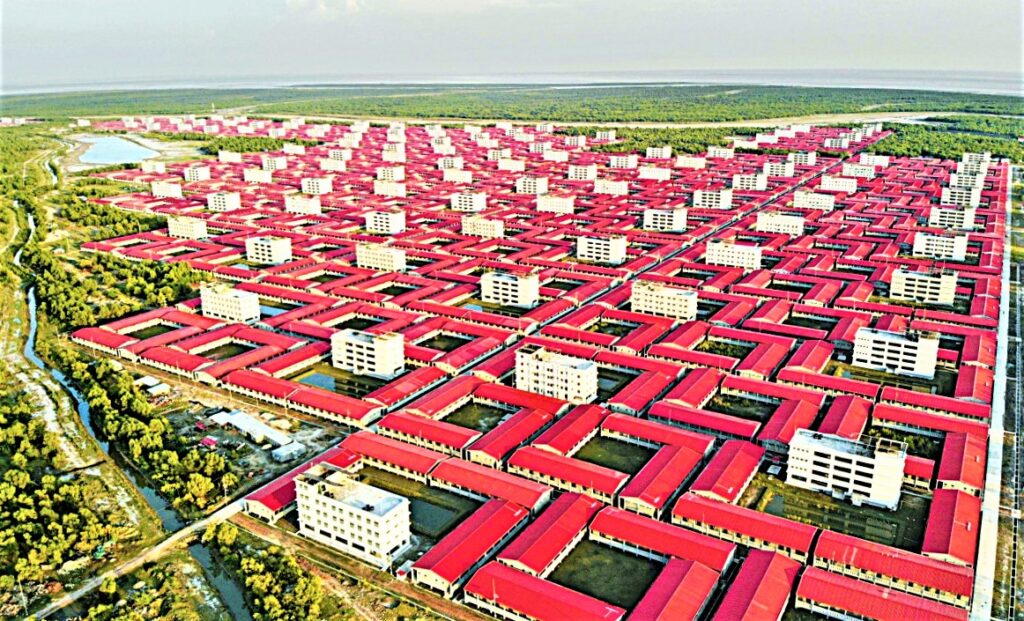
The New Home of the Rohingyas relocated on the Island of Bhasan Char off the coast of Bangladesh in the Bay of Bengal[43]
“Bangladesh is focused on repatriation of the refugees, and I don’t think they want to make the camps any more comfortable,” an aid worker who asked to remain anonymous told CBS News.[43]
While many refugees still don’t want to return to Myanmar because of the violence and trauma they faced there, there are others who hope to go back home, one day.[44]
The persecution of Rohingyas continues in Myanmar according to a report of 26th August 2022. The Myanmar army has continued to lay siege to several communities in southern Sagaing Region over the past two weeks, with resistance groups using explosives to ambush the junta columns responsible for the attacks. Around 20 villages in the townships of Yinmabin, Pale and Kani, which are also strongholds of armed resistance forces west of the Chindwin River, have been targeted since early August 2022, as the military traverses the area.
The same army columns that launched a three-day raid on the village of Yin Paung Taing in Yinmabin on 11th August 2022, killing at least 18 people, have been seen by locals travelling into Pale and more recently, entering Kani. The troops took more than 20 men as porters and hostages when they left Yin Paung Taing, only three of whom had been released at the time of reporting.[45] The 60 soldiers went on to raid at least six more villages at the township border between Yinmabin and Pale, which lies to the south. They travelled north and arrived at the village of Ka Paing., Thee Kone in Yinmabin on August 18, where they clashed with local anti-junta defence forces.
Four members of the resistance and one civilian were killed there, according to local sources.
The civilian was a 68-year-old man whose body was found the next day in one of 200 houses torched by the military during the attack. Among the resistance fighters killed in the clash was a 17-year-old boy. Only one of the four slain defence force members was found to have been shot to death; three were killed by artillery shells or fatally stabbed. They belonged to a local guerrilla group called the Sayar San People’s Defence Force , named for the leader of an anti-colonial rebellion in Myanmar nearly 100 years ago. “The soldier set houses on fire in every village they pass through. They do so whether or not we engage them in a clash. So we fought,” a squadron commander from the Sayar San told Myanmar Now.[46] “The smell of rotten flesh was everywhere”. Several civilians killed in junta assault on Sagaing village. Eighteen people are found dead after a prolonged Myanmar army assault on a Yinmabin Township village involving airstrikes, a ground offensive and days of occupation.[47] He added that much of the population of the targeted communities west of the Chindwin River had been forced to flee the recent raids and had been staying in other communities or hiding in the woods.
“Those families affected by the fires left for their relatives’ homes in other nearby areas, and those who were not affected didn’t dare to stay in their own houses anymore,” he explained. Detailed figures on the number of locals displaced by the attacks were not available at the time of reporting. By Tuesday, the troops in question had arrived in Kani Township, north of Yinmabin. Local defence forces ambushed the column several times, setting up improvised explosive devices along the road connecting the Sagaing cities of Monywa and Kalaywa, part of the highway that links India, Myanmar and Thailand and passes through Kani. A member of a Kani-based resistance group said that the junta had suffered heavy casualties during the explosive attacks, but Myanmar Now was unable to verify his claim.[48]
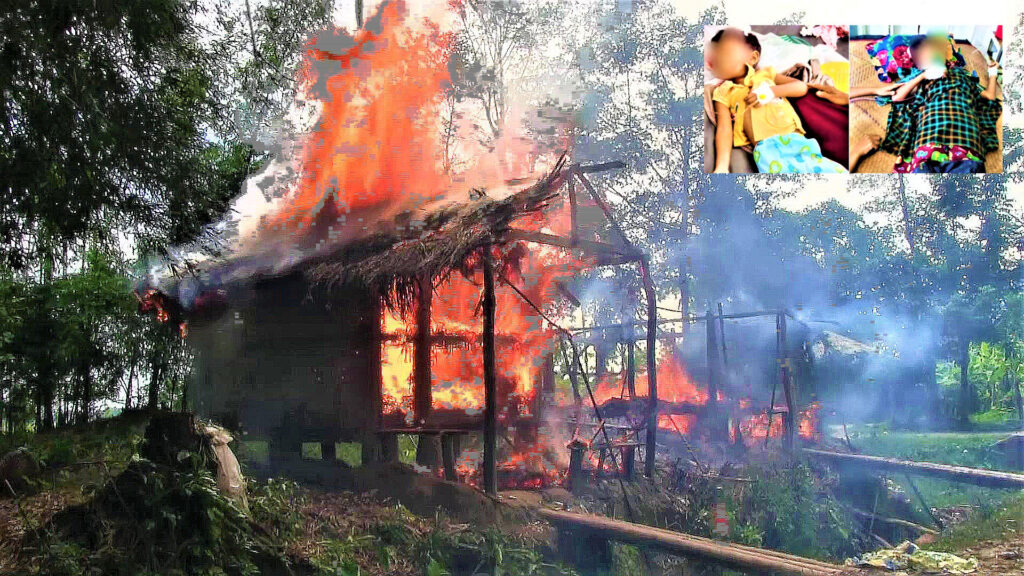
Current photo of a Rohingya village being burnt by the Myanmar Military Junta.
Inset: Two children injured by Myanmar army shelling in eastern Bago Region on 30th August 2022
The Bottom Line is that in the 21st century, “children have become frontline targets”, indirectly due to war and conflict situations in the countries of their origins. This has created internal displacement and strife, or mass exodus to neighbouring countries as stateless refugees, living under appalling conditions. The basic question, we humanoids, need to ask is “What is the future of these Rohingya and other children, in similar conflict situations and what is the world doing about these massive crises, affecting children and minors?” Realistically, NOUGHT![49]
This is particularly evident in Cox’s Bazaar in Bangladesh. “We are hopeful that the future will be better,” Maung told CBS News[50]. “We are not a hopeless people. We want to go back to our country. We want justice and we want our dignity back.” This unfortunate mass of humanoids has been subjected to mass genocide, in Myanmar, dehumanised and discriminated in their own country, where they are regarded as foreigners, have settled in Bangladesh, where, once again Islamophobia and profound disdain have reared their monstrous head, leading to the Rohingyas been subjected to further atrocities and exploitation. The United Nations, human rights chief Michelle Bachelet[51], who visited the Cox’s Bazar camp in August 2022, said the conditions in Myanmar still were not safe, nor appropriate for the Rohingyas to return home, to Bangladesh. However, Bangladesh’s Prime Minister, Sheikh Hasina[52], told Bachelet they would have to be repatriated. “The Rohingya are nationals of Myanmar and they have to be taken back,” Hasina was quoted as saying by her press secretary, Ihsanul Karim, earlier in August 2022. It is in the interest of most stakeholders that the refugees are ultimately able to go back home. “But for now, it’s a long-term crisis,” McLysaght, of Concern Worldwide[53], told CBS News. “Children have been born in the camps. Those children don’t know of any other life. It’s going to be many more years of this camp life, at least.”
Myanmar’s own military, along with extremist Buddhist groups in the country, have been subjecting the Rohingyas to a campaign of sexual violence, torture, arbitrary arrests, burning of babies and entire Rohingya villages, with carefully orchestrated mass killings for many years. In March 2022, The United States, Secretary of State Antony Blinken[54] said the violent repression of the Rohingyas in Myanmar amounted to genocide.[55] “The day will come when those responsible for these appalling acts will have to answer for them,” Blinken said, laying the groundwork for potential legal action. Myanmar is currently facing a genocide trial in the International Court of Justice, in a case filed by Gambia[56].
Realistically, five years on, “no one has been held accountable,” The Human Rights Watch said in a statement released recently, widely considered the fifth anniversary of the mass migration of Rohingya refugees. “This anniversary should prompt concerned governments to take concrete action to hold the Myanmar military to account and secure justice and safety for the Rohingya in Bangladesh, Myanmar, and across the region.” Despite the reminder, refugees like Maung see little reason to hope. “The world seems to have forgotten the Rohingyas,” he told CBS News. While that is the stark reality, the children who were born in Cox’s Bazaar, are now five years old. Others who migrated to Cox’s Bazaar with their parents in 2017, have grown five years older, under the most pathetic coadditions, as a lost generation of Rohingyas.
References:
[1] Personal quote by author September 2022
[2] https://www.crisisgroup.org/asia/south-east-asia/myanmar/292-myanmars-rohingya-crisis-enters-dangerous-new-phase
[3] https://www.theguardian.com/world/2018/aug/27/myanmars-military-accused-of-genocide-by-damning-un-report
[4] https://www.hrw.org/news/2020/01/23/world-court-rules-against-myanmar-rohingya
[5] Hunt, Katie (13 November 2017). “Rohingya crisis: How we got here”. CNN.
[6] https://news.un.org/en/story/2019/05/1037891
[7] http://www.voanews.com/a/rohingya-refugees-seek-to-return-home-to-myanmar/3617130.html
[8] https://www.theguardian.com/world/2016/nov/24/rohingya-flee-to-bangladesh-to-escape-myanmar-military-strikes
[9] https://news.un.org/en/story/2018/03/1004232
[10] https://www.reuters.com/article/us-myanmar-rohingya-idUSKBN1AM0DU
[11] https://catalogue.nla.gov.au/Record/7857480
[12] https://www.thedailystar.net/rohingya-crisis/news/dutch-house-representatives-adopts-motion-probe-rohingya-genocide-1767124
[13] https://apnews.com/8972bde7517d4e7aba770fb124a40726
[14] https://thethaiger.com/news/regional/myanmar-prepares-for-the-repatriation-of-2000-rohingya
[15] https://www.bbc.com/news/world-asia-42094060
[16] https://www.aljazeera.com/news/2022/8/17/rohingya-refugees-have-to-be-taken-back-bangladesh-pm-says
[17] https://www.un.org/sg/en/content/sg/note-correspondents/2022-08-25/note-correspondents-un-secretary-general%E2%80%99s-special-envoy-heyzer-calls-for-increased-support-for-rohingya-refugees-and-host-communities-during-bangladesh
[18] https://en.wikipedia.org/wiki/Rohingya_genocide#:~:text=Taub%2C%20Amanda%3B%20Fisher%2C%20Max%20(31%20October%202017).%20%22Did%20the%20World%20Get%20Aung%20San%20Suu%20Kyi%20Wrong%3F%22.%20The%20New%20York%20Times.%20Archived%20from%20the%20original%20on%2014%20November%202017.
[19] https://www.youtube.com/watch?v=RqnuIc72QJI
[20] https://www.cnn.com/2018/03/12/asia/myanmar-rohingya-un-violence-genocide-intl/index.html
[21] http://www.thedailystar.net/frontpage/mayanmar-rohingya-refugee-crisis-myanmar-found-guilty-genocide-1466263
[22] https://web.archive.org/web/20170908123230/https://www.nytimes.com/2017/09/08/world/asia/myanmar-rohingya-refugees-270000.html
[23] https://www.reuters.com/article/us-myanmar-rohingya-un/myanmar-generals-had-genocidal-intent-against-rohingya-must-face-justice-u-n-idUSKCN1LC0KN
[24] https://www.theguardian.com/world/2020/jan/23/international-court-to-rule-on-rohingya-genocide-safeguards
[25] https://www.reuters.com/article/us-myanmar-rohingya-facebook-idUKKCN1GO2PN
[26] https://www.economist.com/asia/2020/10/22/in-myanmar-facebook-struggles-with-a-deluge-of-disinformation
[27] https://www.ohchr.org/Documents/HRBodies/HRCouncil/FFM-Myanmar/A_HRC_39_64.pdf
[28] https://www.rfa.org/english/news/myanmar/facebook-reaction-08282018153255.html
[29] https://www.rfa.org/english/news/myanmar/facebook-removes-more-pages-and-groups-12192018160943.html
[30] https://www.vice.com/en/article/qjbkpp/facebook-lawsuit-myanmar-genocide-rohingya
[31] Gilbert, David (7 December 2021). “‘Growth Fueled by Hate’: Facebook Sued for $150 Billion Over Myanmar Genocide”. Vice News.
[32] https://www.ohchr.org/EN/HRBodies/HRC/MyanmarFFM/Pages/ReportoftheMyanmarFFM.aspx
[33] https://www.economist.com/leaders/2018/08/30/burmese-generals-should-stand-trial-for-atrocities-against-the-rohingya
[34] https://en.wikipedia.org/wiki/Rohingya_genocide#:~:text=IFRC%20and%20ICRC%2C%20Code%20of%20Conduct%20for%20the%20International%20Red%20Cross%20and%20Red%20Crescent%20Movement%20and%20Non%2DGovernmental%20Organizations%20in%20Disaster%20Relief%20(1994)
[35] Adam Withnall, “Rohingya crisis: Myanmar rejects UN report on genocide after denying investigators access to sites”(29 August 2018) The Independent
[36] https://en.wikipedia.org/wiki/Rohingya_genocide#:~:text=Sara%20Perria%2C%20%22The%20Unmaking%20of%20Myanmar%22%20(21%20September%202017)%20OpenCanada.Org.
[37] https://en.wikipedia.org/wiki/Rohingya_genocide#:~:text=Jonah%20Fisher%2C%20%22UN%20failures%20on%20Rohingya%20revealed%22%20(28%20September%202017)%20BBC%20News
[38] Caroline Gluck, “UN agencies and Myanmar ink agreement, setting the stage for Rohingya return” (6 June 2018) UN News
[39] https://en.wikipedia.org/wiki/Rohingya_genocide#:~:text=Susannah%20Savage%2C%20%22Rohingya%20refugees%20say%20they%20would%20%27rather%20die%27%20than%20be%20sent%20back%20to%20Burma%2C%20as%20repatriation%20plans%20are%20%27stalled%20until%202019%27%22
[40] https://www.bing.com/ck/a?!&&p=18c9acdb3f15c9d5JmltdHM9MTY2MjA3NjgwMCZpZ3VpZD0zOWJhOTNjNy03Mjc4LTYwNTctMmY5Mi05OGMyNzM1MjYxM2YmaW5zaWQ9NTEzMQ&ptn=3&hsh=3&fclid=39ba93c7-7278-6057-2f92-98c27352613f&u=a1aHR0cHM6Ly93d3cuY2JzbmV3cy5jb20vbmV3cy9yb2hpbmd5YS1yZWZ1Z2VlLWNyaXNpcy01LXllYXJzLW15YW5tYXItZ2Vub2NpZGUtYmFuZ2xhZGVzaC1jb3hzLWJhemFyLWNhbXAv&ntb=1
[41] https://www.bing.com/ck/a?!&&p=b58e744f74d17bdbJmltdHM9MTY2MjA3NjgwMCZpZ3VpZD0zOWJhOTNjNy03Mjc4LTYwNTctMmY5Mi05OGMyNzM1MjYxM2YmaW5zaWQ9NTEzMw&ptn=3&hsh=3&fclid=39ba93c7-7278-6057-2f92-98c27352613f&u=a1aHR0cHM6Ly93d3cuY29uY2VybnVzYS5vcmcvcHJlc3MvY29uY2Vybi13b3JsZHdpZGUtYmFuZ2xhZGVzaC1jb3VudHJ5LWRpcmVjdG9yLW9uLWNicy1uZXdzLw&ntb=1
[42] https://www.bing.com/ck/a?!&&p=ce9364accc39fc51JmltdHM9MTY2MjA3NjgwMCZpZ3VpZD0zOWJhOTNjNy03Mjc4LTYwNTctMmY5Mi05OGMyNzM1MjYxM2YmaW5zaWQ9NTE0Ng&ptn=3&hsh=3&fclid=39ba93c7-7278-6057-2f92-98c27352613f&u=a1aHR0cHM6Ly93d3cudGhlZ3VhcmRpYW4uY29tL2dsb2JhbC92aWRlby8yMDIxL21hci8yMy9kZXNwZXJhdGUtcm9oaW5neWEtcmVmdWdlZXMtdGFja2xlLWh1Z2UtYmxhemUtaW4tY294cy1iYXphci1jYW1wcy12aWRlbw&ntb=1
[43] https://www.bing.com/ck/a?!&&p=cf9acc8db3b682e4JmltdHM9MTY2MjA3NjgwMCZpZ3VpZD0zOWJhOTNjNy03Mjc4LTYwNTctMmY5Mi05OGMyNzM1MjYxM2YmaW5zaWQ9NTQzNA&ptn=3&hsh=3&fclid=39ba93c7-7278-6057-2f92-98c27352613f&u=a1aHR0cHM6Ly93d3cudGhlZGFpbHlzdGFyLm5ldC9yb2hpbmd5YS1pbmZsdXgvbmV3cy9iaGFzYW4tY2hhci1iZXR0ZXItY29uZGl0aW9ucy1ob21lLXN0aWxsLWJlY2tvbnMtMzEwMjY4MQ&ntb=1
[44] https://www.bing.com/search?q=While+many+refugees+still+don%27t+want+to+return+to+Myanmar+because+of+the&aqs=edge..69i57.246132j0j1&pglt=41&FORM=ANNTA1&PC=U531#:~:text=those%20who%20fled%20…-,www.cbsnews.com/news/rohingya%2Drefugee%2Dcrisis%2D5%2Dyears%2Dmyanmar%2Dgenocide%2Dba%E2%80%A6,-Was%20this%20helpful
[45] https://www.myanmar-now.org/en/news/myanmar-junta-forces-continue-rampage-through-southern-sagaing-region
[46] https://www.myanmar-now.org/en/news/myanmar-junta-forces-continue-rampage-through-southern-sagaing-region#:~:text=The%2060%20soldiers,told%20Myanmar%20Now.
[47] https://www.myanmar-now.org/en/news/myanmar-junta-forces-continue-rampage-through-southern-sagaing-region#:~:text=%E2%80%98The%20smell%20of,days%20of%20occupation
[48] https://www.myanmar-now.org/en/news/myanmar-junta-forces-continue-rampage-through-southern-sagaing-region#:~:text=He%20added%20that,verify%20his%20claim.
[49] https://www.myanmar-now.org/sites/myanmar-now.org/files/news-images/shwegyin_victims.jpg
[50] https://www.bing.com/ck/a?!&&p=e5cacbddfd2c467fJmltdHM9MTY2MjA3NjgwMCZpZ3VpZD0zOWJhOTNjNy03Mjc4LTYwNTctMmY5Mi05OGMyNzM1MjYxM2YmaW5zaWQ9NTE0OQ&ptn=3&hsh=3&fclid=39ba93c7-7278-6057-2f92-98c27352613f&u=a1aHR0cHM6Ly93d3cuY2JzbmV3cy5jb20vbmV3cy9yb2hpbmd5YS1yZWZ1Z2VlLWNyaXNpcy01LXllYXJzLW15YW5tYXItZ2Vub2NpZGUtYmFuZ2xhZGVzaC1jb3hzLWJhemFyLWNhbXAv&ntb=1
[51] https://www.bing.com/ck/a?!&&p=7bdb5394948f8594JmltdHM9MTY2MjA3NjgwMCZpZ3VpZD0zOWJhOTNjNy03Mjc4LTYwNTctMmY5Mi05OGMyNzM1MjYxM2YmaW5zaWQ9NTE3OA&ptn=3&hsh=3&fclid=39ba93c7-7278-6057-2f92-98c27352613f&u=a1aHR0cHM6Ly9lbi53aWtpcGVkaWEub3JnL3dpa2kvTWljaGVsbGVfQmFjaGVsZXQ&ntb=1
[52] https://www.bing.com/ck/a?!&&p=1e3ceae760881c2fJmltdHM9MTY2MjA3NjgwMCZpZ3VpZD0zOWJhOTNjNy03Mjc4LTYwNTctMmY5Mi05OGMyNzM1MjYxM2YmaW5zaWQ9NTE3NA&ptn=3&hsh=3&fclid=39ba93c7-7278-6057-2f92-98c27352613f&u=a1aHR0cHM6Ly9lbi53aWtpcGVkaWEub3JnL3dpa2kvU2hlaWtoX0hhc2luYQ&ntb=1
[53] https://www.bing.com/ck/a?!&&p=4a7a418b9c555addJmltdHM9MTY2MjA3NjgwMCZpZ3VpZD0zOWJhOTNjNy03Mjc4LTYwNTctMmY5Mi05OGMyNzM1MjYxM2YmaW5zaWQ9NTE0NQ&ptn=3&hsh=3&fclid=39ba93c7-7278-6057-2f92-98c27352613f&u=a1aHR0cHM6Ly93d3cuY29uY2VybnVzYS5vcmcvcHJlc3MvY29uY2Vybi13b3JsZHdpZGUtYmFuZ2xhZGVzaC1jb3VudHJ5LWRpcmVjdG9yLW9uLWNicy1uZXdzLw&ntb=1
[54] https://www.bing.com/ck/a?!&&p=f0a36e3213d9edeaJmltdHM9MTY2MjA3NjgwMCZpZ3VpZD0zOWJhOTNjNy03Mjc4LTYwNTctMmY5Mi05OGMyNzM1MjYxM2YmaW5zaWQ9NTE3NA&ptn=3&hsh=3&fclid=39ba93c7-7278-6057-2f92-98c27352613f&u=a1aHR0cHM6Ly9lbi53aWtpcGVkaWEub3JnL3dpa2kvQW50b255X0JsaW5rZW4&ntb=1
[55] https://www.bing.com/ck/a?!&&p=619aaf2d7028e32eJmltdHM9MTY2MjA3NjgwMCZpZ3VpZD0zOWJhOTNjNy03Mjc4LTYwNTctMmY5Mi05OGMyNzM1MjYxM2YmaW5zaWQ9NTM5NA&ptn=3&hsh=3&fclid=39ba93c7-7278-6057-2f92-98c27352613f&u=a1aHR0cHM6Ly93d3cubGF0aW1lcy5jb20vd29ybGQtbmF0aW9uL3N0b3J5LzIwMjItMDMtMjEvdXMtc2F5cy1teWFubWFyLXJlcHJlc3Npb24tb2YtbXVzbGltLXJvaGluZ3lhLWlzLWdlbm9jaWRlIzp-OnRleHQ9VmlvbGVudCUyMHJlcHJlc3Npb24lMjBvZiUyMHRoZSUyMGxhcmdlbHklMjBNdXNsaW0lMjBSb2hpbmd5YSUyMHBvcHVsYXRpb24sYW5kJTIwbGF5JTIwdGhlJTIwZ3JvdW5kd29yayUyMGZvciUyMHBvdGVudGlhbCUyMGxlZ2FsJTIwYWN0aW9uLg&ntb=1
[56] https://www.bing.com/ck/a?!&&p=e71aeb97c676b1a3JmltdHM9MTY2MjA3NjgwMCZpZ3VpZD0zOWJhOTNjNy03Mjc4LTYwNTctMmY5Mi05OGMyNzM1MjYxM2YmaW5zaWQ9NTM5OA&ptn=3&hsh=3&fclid=39ba93c7-7278-6057-2f92-98c27352613f&u=a1aHR0cHM6Ly9iZG5ld3MyNC5jb20vbmVpZ2hib3Vycy8yMDE5LzExLzIxL215YW5tYXItb24tdHJpYWwtZm9yLXJvaGluZ3lhLWdlbm9jaWRlLS10aGUtbGVnYWwtY2FzZXMjOn46dGV4dD1JTlRFUk5BVElPTkFMJTIwQ09VUlQlMjBPRiUyMEpVU1RJQ0UlM0ElMjBFYXJsaWVyJTIwdGhpcyUyMG1vbnRoJTIwdGhlLG1lbWJlciUyMHN0YXRlcyUyMG9mJTIwdGhlJTIwT3JnYW5pc2F0aW9uJTIwb2YlMjBJc2xhbWljJTIwQ29vcGVyYXRpb24u&ntb=1
______________________________________________
 Professor G. Hoosen M. Vawda (Bsc; MBChB; PhD.Wits) is a member of the TRANSCEND Network for Peace Development Environment.
Professor G. Hoosen M. Vawda (Bsc; MBChB; PhD.Wits) is a member of the TRANSCEND Network for Peace Development Environment.
Director: Glastonbury Medical Research Centre; Community Health and Indigent Programme Services; Body Donor Foundation SA.
Principal Investigator: Multinational Clinical Trials
Consultant: Medical and General Research Ethics; Internal Medicine and Clinical Psychiatry:UKZN, Nelson R. Mandela School of Medicine
Executive Member: Inter Religious Council KZN SA
Public Liaison: Medical Misadventures
Activism: Justice for All
Email: vawda@ukzn.ac.za
Tags: Bangladesh, Buddhists, Burma/Myanmar, Children, Coup, Culture of Violence, Direct violence, Genocide, Migrants, Military Intervention, Muslims, Refugees, Rohingya, South Asia, Torture, Warfare
This article originally appeared on Transcend Media Service (TMS) on 5 Sep 2022.
Anticopyright: Editorials and articles originated on TMS may be freely reprinted, disseminated, translated and used as background material, provided an acknowledgement and link to the source, TMS: The Children of the Gods of War (Part 2): The Ongoing Rohingya Genocide, is included. Thank you.
If you enjoyed this article, please donate to TMS to join the growing list of TMS Supporters.

This work is licensed under a CC BY-NC 4.0 License.
